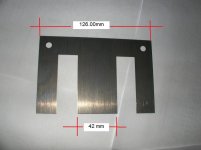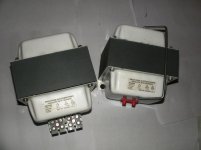any of you transformer guys know if this is even possible:
on P Turner's website - page PP OPT calcs Page 3 there is a small diagram/overview of a transformer and the primary and secondary are interleaved [hope that's the right word].
Is this even possible either hand winding or automated ?
After the bottom section of the primary has been laid if you then start the secondary above it and try to wind either in the same or opposite direction the primary winding below basically will tangle every which way ? Or am I missing something completely obvious ?
His diagram seems impossible.
have you tried to wind your own transformers before?
Patrick is very good at what he does, like him i use a manual hand winder.....it is entirely doable and not that hard, just more work....
the interleaving or sandwiched windings is pretty much the norm used by all OPT manufacturers....
No havn't tried it yet.
Unfortunately I don't own a hand winder, that's probably why I havn't actually tried it so far and just thought about.
I have a couple of small stepper motors though so am going to try to use those to automate it from the start. Inspired by a guy on Youtube from Japan: *How to make the audio transformer*. I suppose if there is only a layer or two of secondary windings it would be quite doable by hand but doing it manually you still have to basically stop turning the hand winder and literally wrap each turn on the bobbin like threading a needle ?
If only I could automate that, there must be a way if that's the way Hammond does it. I cannot imagine their employees threading each turn by hand!
Unfortunately I don't own a hand winder, that's probably why I havn't actually tried it so far and just thought about.
I have a couple of small stepper motors though so am going to try to use those to automate it from the start. Inspired by a guy on Youtube from Japan: *How to make the audio transformer*. I suppose if there is only a layer or two of secondary windings it would be quite doable by hand but doing it manually you still have to basically stop turning the hand winder and literally wrap each turn on the bobbin like threading a needle ?
If only I could automate that, there must be a way if that's the way Hammond does it. I cannot imagine their employees threading each turn by hand!
No havn't tried it yet.
Unfortunately I don't own a hand winder, that's probably why I havn't actually tried it so far and just thought about.
I have a couple of small stepper motors though so am going to try to use those to automate it from the start. Inspired by a guy on Youtube from Japan: *How to make the audio transformer*. I suppose if there is only a layer or two of secondary windings it would be quite doable by hand but doing it manually you still have to basically stop turning the hand winder and literally wrap each turn on the bobbin like threading a needle ?
If only I could automate that, there must be a way if that's the way Hammond does it. I cannot imagine their employees threading each turn by hand!
audio transformer winding is more of an art than science, the technics and materials used are what give them their distinct qualities or lack of...
there are a lot of videos on youtube about making transformers....
making transformers by hand is hardwork...
I have just had my eureka moment, the wires between sections, say primary can be cut and resoldered to the next primary section above ? I would have thought that destroys the inductance though.
yes, that is the idea....phasing is important if done wrong you will have a useless transformer.....
here is a good source of information.... http://www.dissident-audio.com/Transfos/Papers/Wolpert_Audio_Xfmr_Design_Manual.pdf
I have just had my eureka moment, the wires between sections, say primary can be cut and resoldered to the next primary section above ? I would have thought that destroys the inductance though.
Cutting the wire has no effect on inductance. All that matters is the total number of turns of all the winding you put in series.
That is how "everyone" does it. After winding a layer you cut the wire and put a little tag on it so you can remember. Or you can buy wires with various different color insolation. Then later after the last winding is in place, you solder the wires and put the colored lead wires in, then some more tape.
Thanks Tony for the reference.
That guy Wolpert also wrote a power transformer manual, you don't happen to have a reference for that one as well do you ? The original source for that book , his daughter I think, has sort of disappeared. Sent off a few e-mails ages ago but never got a reply.
Another great one is a book from 70s written by a guy called Lowden. Practical Transformer Design Handbook. Really good book.
That guy Wolpert also wrote a power transformer manual, you don't happen to have a reference for that one as well do you ? The original source for that book , his daughter I think, has sort of disappeared. Sent off a few e-mails ages ago but never got a reply.
Another great one is a book from 70s written by a guy called Lowden. Practical Transformer Design Handbook. Really good book.
Thanks Tony for the reference.
That guy Wolpert also wrote a power transformer manual, you don't happen to have a reference for that one as well do you ? The original source for that book , his daughter I think, has sort of disappeared. Sent off a few e-mails ages ago but never got a reply.
Another great one is a book from 70s written by a guy called Lowden. Practical Transformer Design Handbook. Really good book.
"Audo Transformer Design Manual" by Robert Wolpert
This book teaches you how to design an audio transformer to match a set of requirements. He uses a step by step engineering method. Math is only at the advanced high school level
I think this is a case where the copyright holder and his family just don't care about this any more. I have a scanned copy. send me an email albertson.chris at gmail dot com.
Question: Did he also write a power transformer book? PTs are much simpler and a good place to start.
have you seen the book posted at YvesM's website, is it different from yours? http://www.dissident-audio.com/Trans...ign_Manual.pdf
have you seen the book posted at YvesM's website, is it different from yours? http://www.dissident-audio.com/Trans...ign_Manual.pdf
Your link did not work but i was able to find the book I have on that site. The link below is the same book I have. Except I OCR'd my copy to make it searchable. This book is good and it answers most of the questions that come up in these forums. The other one to get a "Radiotron" 4th ed. on Pete Millet's web site. The section on transformers is good.
http://www.dissident-audio.com/Transfos/Papers/Wolpert_Audio_Xfmr_Design_Manual.pdf
Winding my own trafo
Hi to all.
Buying a new trafo is expensive, since i have two stepdown(220->110) I'm planning to build my own with the below spec:
Input: 220V/50Hz
Output: 45VAC centertap
18VAC centertap
VA: as per the label it's 1000VA
Now with your help please let me know the following:
Hi to all.
Buying a new trafo is expensive, since i have two stepdown(220->110) I'm planning to build my own with the below spec:
Input: 220V/50Hz
Output: 45VAC centertap
18VAC centertap
VA: as per the label it's 1000VA
Now with your help please let me know the following:
- Primary winding(turns)
- Secondary windings(turns)
- Primary wire gauge
- Secondary wire gauge
Attachments
42 * 51mm = 2142mm² = 3.32sq in of core area.
VA ~ 31 * Core area² ~ 31 *3.32*3.32 ~ 340VA for the smaller stack and ~ [60/51]² higher for the bigger stack i.e. ~ 470VA.
Certainly not 1000VA.
If you added the two stacks together (not ideal because the stack shape is 42*111= very non square) you could get ~~ 1.6kVA. But there would be relatively small window area for sufficient copper to keep the resistances low.
87mm stack gives ~1kVA
VA ~ 31 * Core area² ~ 31 *3.32*3.32 ~ 340VA for the smaller stack and ~ [60/51]² higher for the bigger stack i.e. ~ 470VA.
Certainly not 1000VA.
If you added the two stacks together (not ideal because the stack shape is 42*111= very non square) you could get ~~ 1.6kVA. But there would be relatively small window area for sufficient copper to keep the resistances low.
87mm stack gives ~1kVA
Last edited:
- Home
- Amplifiers
- Power Supplies
- Tony's latest traffo DIY build

